|
Hadj
(الحجّ)
Arabic. Muslim pilgrimage to
Mecca, known as the 'third pillar' of Islam, which every devout Muslim
seeks to make at least once in his lifetime.

Hai Chan Zi (海蟾子)
See
Liu Hai.

Haimavati
Sanskrit. 'Born from the
Himalayas'. One of the benevolent forms of Devi, Shiva's consort.

Hamsa
(हंस)
Sanskrit. A sacred goose,
gander or swan, and the mount of the Hindu god Brahma. Its flight
indicates the connection between the aquatic world and the heavens. It
is frequently seen in Buddhist iconography. In Pali hongse. See also
Hamsa.

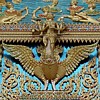
Hamsa (خمسة, חמסה)
Arabic-Hebrew. Name for a
symbol consisting of a hand that contains the motif of an eye which is
believed to ward off evil, or the evil eye, and used as amulet. By
Muslims it is also known as the hand (or eye) of Fatimah, the daughter
of Muhammad, and by Jews as the hand of Miriam, the sister of Moses and
Aaron'. Some associate the meaning of the five fingers to the five books
of the Torah for Jews, or to the Five Pillars of Islam for Sunni Muslims
(the Shi'ite sect submit to eight precepts). See also
Hamsa.

Han Hsiang Tzu (韩湘子)
Chinese. Name of one of the
Eight Immortals, who was the nephew of Han Yu, a prominent poet and
statesman of the Tang dynasty whom he tried to persuade to renounce his
political career and pursue Tao instead. He has a magical flute that has
the ability to give life and produces music that can make flowers bloom
in the twinkling of an eye and soothe wild animals. In his effort to
convince his uncle to abandon his life of officialdom and to study Tao,
Han Hsiang Tzui performed some miracles, such as filling a goblet with
excellent wine, pouring out cup after cup from a gourd without end,
using the power of Tao, as well as predicting events that would occur in
his uncle's life, all of which would later come true. He is also known
as Han Xiangzi and usually referred to as the Philosopher Han Hsiang,
also transcribed Han Xiang. Being portrayed as a youthful boy playing a
flute he is often reminiscent of some depictions of Krishna, who is a
master of the bansuri, an northern Indian, bamboo flute. Compare his
magical flute also with that of Phra Aphaimanih.

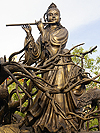
Hanuman (हनुमान्, หนุมาน)
1. Sanskrit-Thai. Monkey from
East India. 2. Sanskrit-Thai. The son of Vayu, the god of wind, in Thai
known as Sawaha and Phra Phai. He is the albino half-god monkey who
assisted Rama in his battle against Ravana in the Indian epic Ramayana.
He is depicted with a white complexion and has a diamond in the middle
of his palate. He is the king of the monkeys and a general who has
magical powers and whose yawn could produce moons and stars. His
personal weapon is a diamond trident which he uses to combat important
adversaries. He appears in the Thai Ramakien, for one. Also Wayubud.

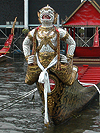
Hara
(हर)
Sanskrit. A name for Shiva.

Hari
(हरि)
Sanskrit. A name for Vishnu.

Harihara (हरिहर, หริหระ)
Sanskrit-Thai. A Hindu deity
that derives its name and characteristics from both Vishnu (Hari) and
Shiva (Hara), and is a combination of these two gods. Usually depicted
with Vishnu's crown on one side of his head and Shiva's jata (plaited
hair) on the other. He also holds the main attributes of both gods.


he (鹤)
Chinese for crane. The word is
a homonym of
he.

he (合)
Chinese. 'To combine, unite,
join' or 'to gather'. The word is a homonym of
he.

hell
See
narok.

hell
banknote
See
ming bi.

hell
money
See
ming bi.

hera
Mythological monster often seen
at the end of an arch. It has the body of a naga and its teeth meet its
nostrils whilst often another creature, flower or flame-like motif
emerges from its open mouth.

Hevajra
Sanskrit. A protective god in
Tantric Buddhism with the rank of a buddha. He has eight heads, sixteen
arms, and two or four legs, and a third eye. In Cambodia and Thailand he
is usually depicted in a dancing posture with his left leg crushing a
demon and his right leg bent with the foot touching the left leg above
the knee. See also
Nataraja.

hijab
(حجاب)
Arabic. Term for a 'cover', its
root meaning 'to veil, cover, screen' or 'to shelter', and it refers to
the covering of both the head and body of Islamic women. In Islamic
theology however, the word is given a much wider meaning and refers to
modesty, privacy and morality, whereas the word for headscarf or veil
used in the Koran, is khimar.


Hijrah
Arabic. 'Migration'. The flight
of the prophet Muhammad and the first Muslim community from Mecca to
Medina in 622 AD, the year from which the Muslim calendar is dated.

Himaphan (หิมพาน)
Thai. A mythical forest located
in the Himalayas, below the heavens of the gods. It is often mentioned
in Buddhist literature and inhabited by both real and mythical animals.
Also called Himavat (Himawat), Himavan (Himawan), Himavah (Himawah),
Himavaat (Himawaat), and Himavaan (Himawaan).

Hinayana
Sanskrit. 'Lesser vehicle'. A
term used for Theravada Buddhism after the origin of Mahayana Buddhism,
the 'greater vehicle'. The Hinayana school of Buddhism is closest to the
original teachings of the Buddha. At some point were several different
sects of Hinayana Buddhism but today only the Theravada school remains.
It is practiced in Sri Lanka and Southeast Asia, and uses Pali as its
language.

Hinduism
The main religion and social
system in India. Followers, called Hindus, share a common belief in the
law of karma, the transmigration of the soul, and the universal spirit
or brahman. Its religious practices include the veneration of several
deities, and its religious writings are the Vedas and the Ramayana.

hintha
A mythical bird in Burma.

Hok Lok Siw (ฮก ลก ซิ่ว)
Thai-Chinese. Three Chinese
gods who in art are usually depicted as a trio with long beards. They
are generally known as Hok, Lok and Siw, Thai-Chinese names that
represent Happiness, Wealth and Longevity respectively. In Chinese they
are named Fu Lu Shou and in English sometimes referred to as the Three
Star Gods, due to their correspondent stars in ancient Chinese
astronomy. Unlike the order of their names, the god Hok (Fu) is
traditionally placed in the center and is easy recognizable by his
distinctive headdress. Siw (Shou), the god of longevity always carries a
staff with a dragonhead and the Peach of Immortality in his hands, and
has a semi-bald, oversized, abnormally high forehead. He is sometimes
shown to carry a nahm tao bottle gourd. Lok (Lu) also wears a hat, but a
smaller one, and carries an imperial scroll with him.


Holi
Sanskrit. Festival associated
with the Hindu god Krishna.

hom pah (ห่มผ้า)
1. Thai. To cover the shoulder
or body with a piece of cloth. 2. Thai. The application of a saffron
cloth to Buddha images.

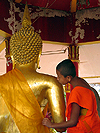
hong
bao (红包)
Chinese. 'Red package'. Red
packages or red envelopes are traditional monetary gifts in Chinese
society which are given during festivals and on special occasions, such
as new year, weddings, etc. The red color symbolizes good luck. The
amount of money in the envelopes, also called lishi, should be of even
numbers, as odd numbers are associated with cash given during funerals
and considered bad luck. However, since the Chinese word for four (sì)
is a homophone for to die (sĭ), any amount of cash with this number
should also be avoided, whereas the number eight (bā) is associated with
wealth and good fortune, and is therefore commonly found in the red
envelopes. During Chinese New Year, hong bao are customarily given by
the elderly who already have an income to the younger who don't yet
work, but in some places it are the married that give to the unmarried,
regardless of age. The tradition of the monetary envelopes goes back to
when elderly Chinese would tie coins together with a red string for
protection against sickness and injuries. These money strings, called
yasui qian, were gradually replaced by red envelopes when printing
presses became more widespread. The hong bao are today still referred to
as yasui qian. In Thai called hang pao.


hongse
Pali-Thai. 'Swan'. In Thailand
a mythical swan often depicted in art and architecture, such as in the
middle of temple roofs in northern Thai style, as well as the antefix on
some Buddhist temples, known as the hang hongse. In Thai pronounced hong.
In Sanskrit
Hamsa.

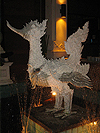
hong thong (หงส์ทอง)
Thai. 'Golden swan'. Another
name for Suphanahongse, a golden hong.

Ho Hsien-ku (何仙姑)
Chinese. Name of the only
female member of the Eight Immortals, often referred to as Immortal
Woman He, a free translation of her name which may also be transcribed
He Xiangu. She was born in Guangdong province as the daughter of a
wealthy family. At the age of fourteen she made a vow to remain a virgin
and a deity appeared to her in a dream. In order to become an immortal
she was instructed to consume very fine powdered mica, a brilliant kind
of mineral. She took the powder as ordered and gradually gave up taking
ordinary food all together, surviving solely on mica crystals. She could
walk so fast, that she seemed to be flying and often wandered in valleys
to gather mountain fruits. Eventually she ascended to heaven and became
an immortal. She is usually portrayed holding a long-stalked lotus
flower, that has the power to improve one's mental and physical health.

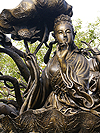
hsien (仙, เซียน)
Chinese-Thai. See
xian.

Hsi Ling Shih (西陵氏)
See
Xi Ling Shi.

Huan Xi Fo (歡喜佛)
Chinese. 'Happy Buddha'.
Popular name of a Buddhist figure who is also known by the Chinese name
Budai. He is the interpretation of the bodhisattva Maitreya, the future
buddha predicted to succeed the Sakyamuni Buddha. He is the god of
happiness and wealth. His image is based on an unconventional Chinese
monk who lived in the time of the Liang Dynasty and is usually depicted
as a deity of satisfaction and abundance, often holding a cloth bag full
with precious items or gold, and other attributes, such as a water jar,
gold coins, a ruyi, a gold ingot, a pagoda, etc. He has integrated into
Buddhist, Taoist and Shinto culture, and is commonly represented as an
obese smiling or laughing figure, hence his nickname. It is believed
that rubbing his belly brings forth happiness, wealth, good luck and
prosperity. He is therefore often worshipped as an informal Chinese
wealth god. Variously called 'laughing Buddha', 'smiling Buddha', Mi Le
Fo and Hotei. In Thailand he is often confused with Phra Sangkatjaai.

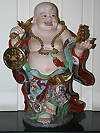
hu lu
(葫芦)
Chinese name for calabash, in
Thai called nahm tao. Also transcribed hoo loo and sometimes wu lou.
 |